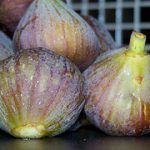
Figs
When to Buy/In Season:
Fig trees produce two crops a year, first in the early summer (the breba crop, on the older branches), and again in the late summer and early fall (main crop, on the new branches). The first crop is larger but less flavored, the second crop is smaller with a more concentrated flavor.
How to Select:
Tree-ripened figs should hang limply from tree branches. Tree-ripened figs are highly perishable; a bruised fig will break down within minutes. Hence, most fresh figs are picked unripe. Unripe figs may include a milky latex on the stem end; this latex is a skin irritant and can irritate the mouth severely. If tree-ripened figs are not available, select dried figs that were picked tree-ripened. Black Mission and Calimyrnas varieties are generally preferred.
Organic Issues:
Conventionally farmed figs are not heavily sprayed with chemicals, but are sprayed annually with methyl bromide, herbicides, and fungicides. A growth regulator, Ethephon, may be sprayed on to speed ripening. Organically grown figs are available.
Pesticide Issues:
EWG 2009 Dirty Dozen, not listed
How to Store:
Fresh figs should be eaten immediately or refrigerated for up to two days.
Figs release ethylene, which can spoil some produce. Store figs away from:
Bananas
Broccoli
Brussels sprouts
Cabbage
Carrots
Cauliflower
Cucumbers
Eggplant
Lettuce and other leafy greens
Parsley
Peas
Peppers
Squash
Sweet potatoes
Watermelon
Freezer
To Freeze Fresh Figs:
- Select fully ripe fruit, wash and peel if desired. Rinse ripe fruit. Be sure to remove stems and then pack in freezer bags.
Syrup Pack: Use 40 percent syrup. For a better product, add 3/4 teaspoon (2250 mg) ascorbic acid or 1/2 cup lemon juice to each quart of syrup. Pack figs into containers and cover with cold syrup, leaving headspace. Seal and freeze.
Dry Pack: To prevent darkening of light colored figs, dissolve 3/4 teaspoon (2250 mg) of ascorbic acid in 3 tablespoons cold water and sprinkle over 1 quart of fruit. Pack figs into containers, leaving headspace. Figs can also be frozen first on a tray and then packed into containers as soon as they are frozen. Seal containers and freeze.
- Frozen fresh figs keep in the freezer for up to one year, however some people find the quality declines
Canning
See our Basics of Canning Fruit at Home
Home Canned fruits can be stored for up to 1 year; they may lose quality after that point. Commercially canned fruit can be stored up to 3 years.
Drying:
See our Basics of Drying Fruit at Home
Dried figs store well at room temperature for up to four months, or may be frozen indefinitely.
Photo Source: pingu1963
Return to Buying and Storage Guide for Fruits


